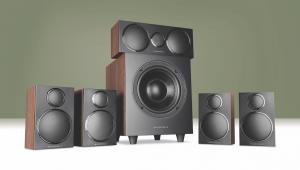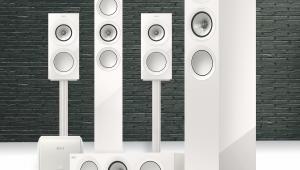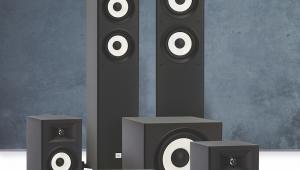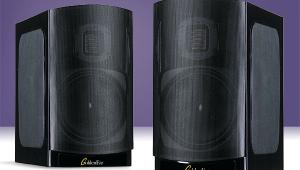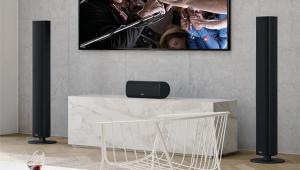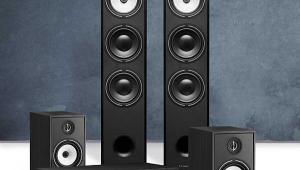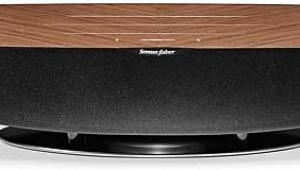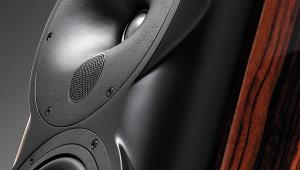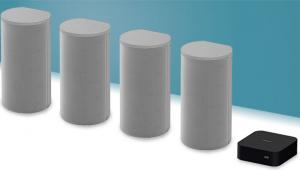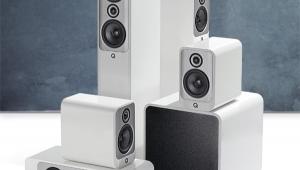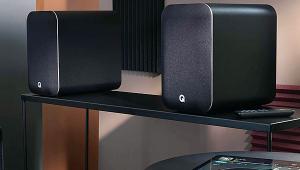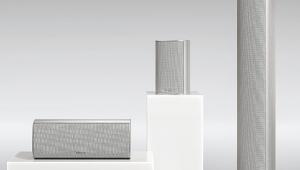Focal Aria 5.1 loudspeaker system
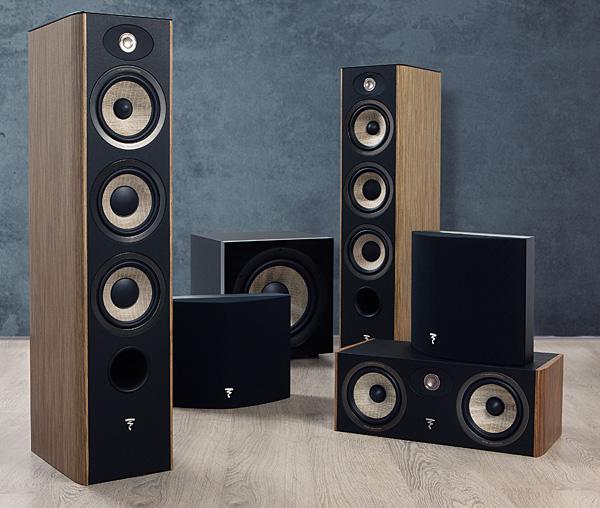
 Does this 5.1 system have the muscle to back up its good looks? asks David Vivian
Does this 5.1 system have the muscle to back up its good looks? asks David Vivian
Focal's speaker lineup goes all the way from bijou to blimey, affordable to 'if you have to ask'. Which is useful when it comes to putting together a 5.1 package that's a few steps above entry-level but, at the same time, isn't going to break the bank, looks fabulous and has the size and wherewithal to fill a big room with movie mayhem – and possess the lightness of touch to play music with grace and finesse, too.
With that as the brief, this multichannel combo seems a nice snug fit. It's based around Focal's lauded Aria family of loudspeakers and offers arguably the keenest value in the whole Focal portfolio, mixing, as it does, the Flax-flavoured driver technology also used in its more quirkily styled (and higher-end) Kanta range (and its custom install-focused 300 Series) with more traditional-looking cabinets.
There's nothing dainty about the front row, which consists of Aria 926 floorstanders (£2,000 per pair), Aria CC 900 centre (£500) and, if you like to keep your sub-bass frequencies radiating close to the LCR action, the front-firing 1000 F subwoofer (£1,100).
At the back are not the Aria 906 standmounts you might expect (although they would fit right in aesthetically) but, stepping up the sophistication quotient, Focal's Aria SR 900 bipoles (£450 each), home cinema-centric models designed to better spread the surround sound around.
Altogether the system cost is £4,500, but you might find it for less. Not bad for a setup that looks as if it should sell a couple of grand more.
What The Flax?
Let's begin at the front with the 926 floorstanders that anchor this system and showcase much of the key 'affordable audiophile' Aria DNA. This handsome threeway tower, in production for a good few years now, is immediately intriguing when you whip off the grille to reveal its distinctive Flax-coned main drivers.
Focal is a great believer in Flax, to the extent that it sources the stuff locally in France and has patented the fibre weave composite it uses for the Aria driver diaphragms. By sandwiching Flax fibre between two thin layers of glass fibre, the resulting cone is claimed to have high internal damping and high flexural rigidity. Focal says that of all the cone materials it could have used, Flax simply sounds more natural, being low in colouration with great dynamics.
Flax is employed in all three of the Aria 926's 6.5in drivers. Being a three-way design, the one closest to the tweeter, spottable via its smaller dustcap, is dedicated to the midrange frequencies while the lower pair work in line to take care of the bass.
If you want to go bigger with your front L/R speakers, Focal will oblige. The 926 is in the middle of the Aria range, below both the triple-bass-driver 936, and the flagship 948, which uses a pair of 8.25in woofers.
The Aria tweeter is unusual, too. As well as sporting an inverted 1in aluminium/magnesium dome (concave rather than convex to make it less directional), the suspension between the dome and its bracket incorporates Poron, a material with what Focal refers to as 'shape memory.' It's a similar arrangement to one Focal employs for the famous Beryllium tweeter in its high-end (and high-price) Utopia range. The benefit of this suspension, says the company, is that it makes it possible to reduce distortion by a factor of three in the 2kHz-3kHz range where the human ear is at its most sensitive.
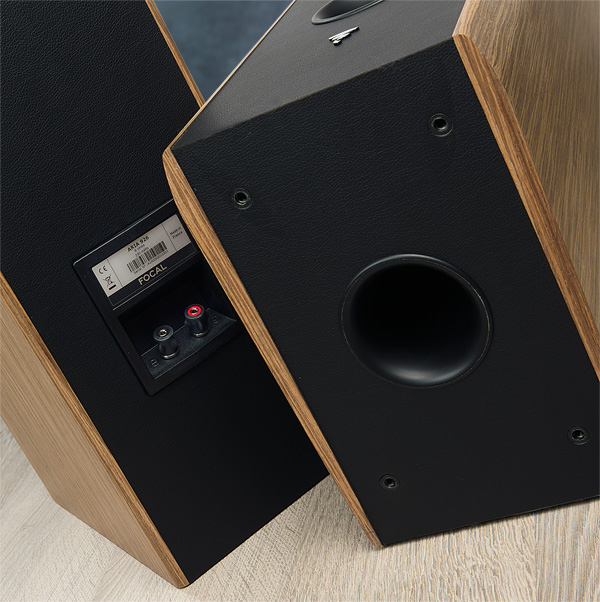
All About That Bass
A chunky lift at 17.8kg, the Aria 926's metre-tall, vinyl- wrapped enclosure is nicely finished and both front and base-ported, a slightly fiddly-to-fit cast plinth [not photographed] providing the required clearance for the latter. Although there's a fairly serious-looking subwoofer with this 5.1 package, these floorstanders are claimed to be fine with the heavy lifting down to 45Hz at -3dB. Connectivity is kept to just single binding posts around the back, so no bi-wiring option – but at least it keeps the cable count down.
Next up is the Aria CC 900 centre speaker. This is a two-way design and in addition to the usual jobs of enhancing speech intelligibility and anchoring the central image, Focal claims it has been 'timbre matched' with the other speakers in the group to provide 'coherence' and 'homogeneity' when they're all working together – maybe not such a tricky ask given that it uses the same 6.5in Flax-coned main drivers and 1in inverted dome tweeter as the 926 floorstander. The rigidly-braced MDF enclosure, which has no parallel sides to discourage internal standing waves, sports twin reflex ports at the rear.
Taking care of bottom octave business and a bit below that, Focal's Sub 1000 F subwoofer is a glossy black cube of modest dimension and weight that is nevertheless very sturdily constructed. A Class D BASH amplifier (rated at 1,000W) powers its 12in Flax-coned woofer, reinforced with an extra layer of fibreglass for additional rigidity. The sealed enclosure design should mitigate any tendency towards 'bottom-end flab' yet Focal claims the 1000 F will dig down to a quaking yet tautly controlled 22Hz at -6dB or 24Hz at -3dB. Integrating it with the rest of the system is relatively straightforward, with Focal providing the standard stereo line-level/LFE input, crossover and phase controls but nothing more exotic than that.
Finally, the Aria SR 900 rears. These are bipole designs with split, angled baffles hosting two sets of drivers to give a more broadly spread sound. They fire in phase, just like the front floorstanders, and this makes them different from visually similar dipole designs where drivers are wired out of phase to create a null at the listening position which, the theory goes, gives a more atmospheric surround effect. Either way, both 'bi-' and 'di-' types are dedicated to rear speaker duties – more so than conventional two-way standmounts.
Each SR 900 enclosure has four drivers – two 5in Flax-coned midbass units and a brace of aluminium/magnesium inverted dome tweeters. Conveniently shallow front-to-back, they look more 'cinema', too – ideally proportioned for wall-mounting and the necessary Polyfix brackets are supplied in the packaging.
 |
Home Cinema Choice #351 is on sale now, featuring: Samsung S95D flagship OLED TV; Ascendo loudspeakers; Pioneer VSA-LX805 AV receiver; UST projector roundup; 2024’s summer movies; Conan 4K; and more
|




